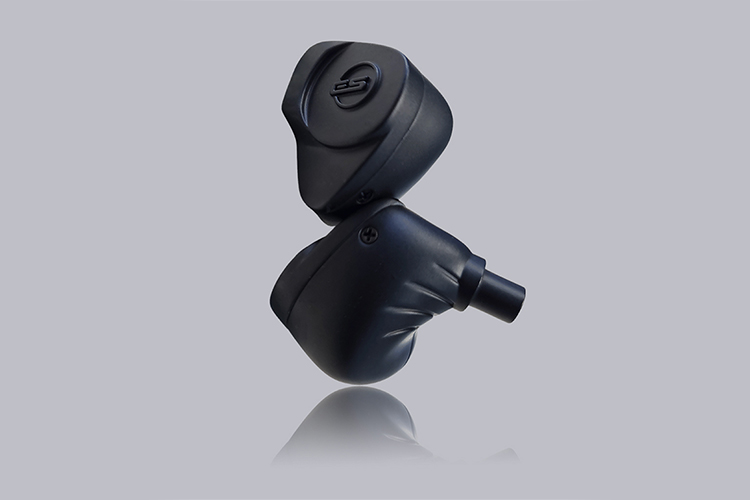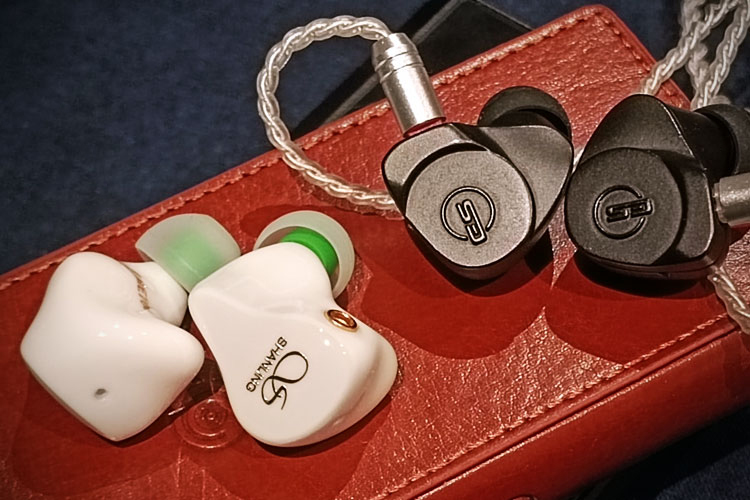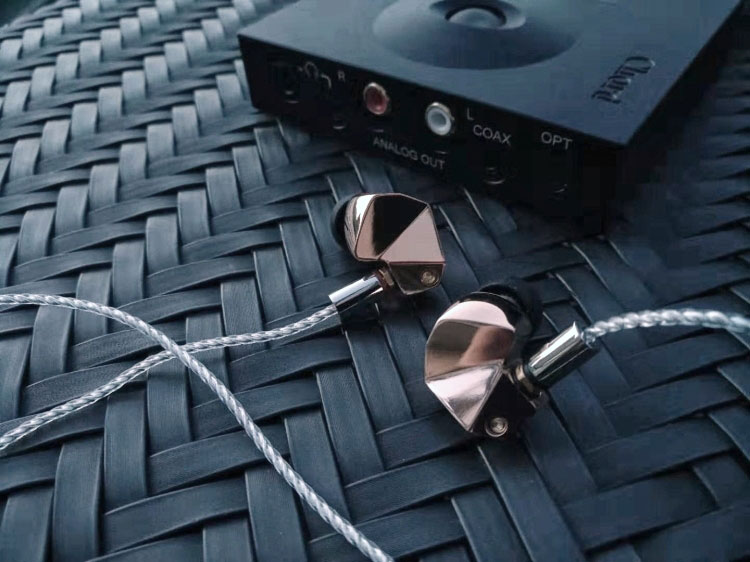Synergy
Efficiency
The ONYX is quite sensitive and can go loud even on a phone as it measures 16.5Ω in impedance and 122dB/mW for sensitivity.
You can drive it off from a phone or the laptop easily and it will not sound muddy but giving it more amping power will further bring up the resolution and control. Being quite sensitive you may hear a small faint in the background but it is negligible when you have a good source or listening outdoor.
I have been trying the ONYX with my laptop, phones, DAPs like the Shanling M3X, as well as desktop amplifiers.
The tuning favors scaling with power and when pairing with a powerful DAP on an amplifier, you can feel the bass tightened up and punch firmer, while good balanced in the output is maintained. It doesn’t need a lot of power but faster amping, or a more colored amping stage would help the ONYX to sound more engaging.
Pairings
The ONYX’s base tuning is quite neutral so it is not likely to sound veiled or flat with any pairing. It pairs well with phones and my MacBook but it has great synergy with gears that have better decoding quality, a balanced tuning, and stronger transients.
For example, the Chord Electronics Mojo 2 or the Lotoo Paw Gold Touch, or even stronger gears that have a lot of texture, for example, the Shanling M9.
Turning to higher gain the vocal is more defined though more noise would be picked up, and decoding quality is more preferred than raw power here.
Paired with my MacBook, there are sufficient dynamics for the ONYX to sound engaging and with streaming contents that has the bass boosted, the bass is well layered and the treble is on the slightly shy side. The small recession in the mid-lows is doing a good job here to compensate for the denser bass which keeps it agile and clean together with the small elevation in the upper mids.
Testing on the FiiO M11 Plus LTD ESS and the non-ESS LTD edition with AKM and ESS implementations, the AKM pairing sounds more elaborated in the mids with stronger transients in the upper mids that makes guitars and vocals more engaging. On the ESS pairing, it sounds smooth with a better balance in tonality.
Select Comparisons
Earsonics CORSA
$450
Technical
The CORSA, the smaller brother to the ONYX, is differed by one dynamic driver. Such makes quite a difference for the specs where the CORSA incorporates an impedance corrector so it measures at 31Ω and 119dB for sensitivity, with good contrast to the ONYX that measures at 16.5Ω and 122dB SPL.
To put it simply, the ONYX requires less current to be driven and it could be driven fairly well from laptops and dongles.
Design
The aesthetics are basically, the same on these two and the CORSA gets a stealth black paint job much like PVD-coated watches. The bigger difference is within the internal structure, which we will explain below in the sound comparison.
Performance
Putting the CORSA and ONYX on the FiiO BTR5 2021 dongle, you can easily feel the difference in sensitivity where the ONYX will pump out more loudness at the same volume setting and delivers clearer, deeper punches also more transparent highs with portable gears like phones or DAPs/ dongles with a smaller output.
With the extra Dynamic driver, the ONYX brings more bass texture into the picture whereas on CORSA it feels more subtle, the ONYX is also more rounded and smoother in the upper mids than on the CORSA which has the crispy details emphasized.
Therefore, on ONYX when you listen to electronic music and soundtracks, it captures the atmosphere better with more details in the lows, and the highs are presented more naturally.
With more power in the output, the CORSA could sound more balanced given its higher impedance, yet the DD in ONYX is still coloring it more organic and authentic in the vocal part and elaborated with synthesized instruments.
Shanling ME700 Lite
$499
Technical
The Shanling ME700 Lite measuring 16Ω, 109dB / mW sensitivity is less sensitive than the ONYX.
Housed in a resin shell, the ME700 Lite is quite feature-rich by adopting a Titanium diaphragm in its DD driver and proprietary BAs, also coming with gold and silver-plated single crystal copper cable.
The 4 BA on the ME700 Lite helps the treble to extend high and Shanling marks the frequency extension up to 40kHz.
Design
The ME700 Lite in light piano white color contrasts highly with the darker, satin black colored ONYX. The sound signature is aligned and in such a way I like both designs as they tell something about the product and make the experience more fun and intuitive.
The ME700 Lite comes with a colorful 4×42 strand single-crystal structure SPC cable that is very soft and does not have any microphonics.
Potential ONYX users will get Earsonics’ HR 8C 8-braid cable with 6N OCC silver Coper Hybrid Alloy Cores that is offered à la carte. The cable on the ONYX is slightly stiffer but feels more durable.
Performance
The impedance design as well as the rigid diaphragm material may give you a hint of how would the ME700 Lite sound. Using my MacBook to compare the two, the ME700 sounds more V-shaped and has higher sharpness in the upper vocal range. Its bass is also faster in impact and decay compared to the ONYX which sounds more elaborated and not as agile.
With such differences in signature and responsiveness to power, I would prefer pairing the ME700 Lite to gear like Questyle M12, or the Cayin RU6, that colors its mids more elaborative.
For ONYX it works well with Hiby R5, M11 Plus, and the M3X for extra crispiness in the highs. When paired with tube amps and R2R devices like the RU6 it gets very smooth.
final B1
$699
Technical
The final B1 has 1BA + 1 proprietary DD under its hood rated at 94dB SPL and 13Ω in impedance. The design does not employ a cross-over network so no frequencies from either the BA driver or the dynamic driver have been cut-off.
The design leverage on final’s research on the relationship between spaciousness, clarity, and dynamic range of the recordings, also the physical characteristics of earphones. In short, the B1 is born as the result to achieve balanced tonality and a higher sense of reality.
Design
The B1 uses an injection-molded case and is polished to be very reflective. The slim profile allows it to balance its weight evenly on the concha such that it won’t stress the ear when listening for long durations.
The B1’s housing is harder to machine technically and looks more luxurious, in contrast, the ONYX is much stealthier and comes with 2-pin housing that is usually more durable.
Performance
The final B1 exhibits a similar tuning direction in the bass to the ONYX, followed by a very smooth mid-range, and a stronger elevation in the treble that brings up the sharpness for cymbals.
Putting both IEMs on the M11 Plus, the B1 boosts the transparency and transients for lighter voices and violins, it is quite a bit more intensive in the higher register. The ONYX, on the other hand, kicks deeper, sounds stronger in the bass, and is more open and energetic with Jazz, EDM, and rock music.
With less treble elevation, the ONYX pictures the soundscape as more natural and fuller-bodied, while the B1 captures transients better. When testing on phones you can feel the ONYX being quite a lot more sensitive and could easily deliver satisfactory punch and separation.
In contrast, B1 sound softer and less defined in the vocal range, yet the B1 could scale better with amplification to deliver bigger bass, resolution, and more defined treble.
Our Verdict
The Earsonics ONYX successfully fills the gap for Earsonics metallic lineup and is perfect for those who want to experience the immersive tuning STARK offers but are reluctant to carry a powerful DAP around.
It is the most efficient IEM in the series with punchy bass and swift articulation that could be easily powered by Bluetooth dongles and phones. I just wish there is a balanced cable that goes with it which could unlock its potential further.
If you are looking for intimate bass, good clarity, and smoothness on an efficient IEM that is ready for daily abuse, this is a decent choice.
Earsonics ONYX Specifications
- Sensitivity: 122 dB/mW
- Frequency Response: 10 Hz -20 kHz
- Impedance: 16.5 ohm
- Driver configuration: 1 Dynamic, 3 Balanced Armatures
Crossover: 3-way






